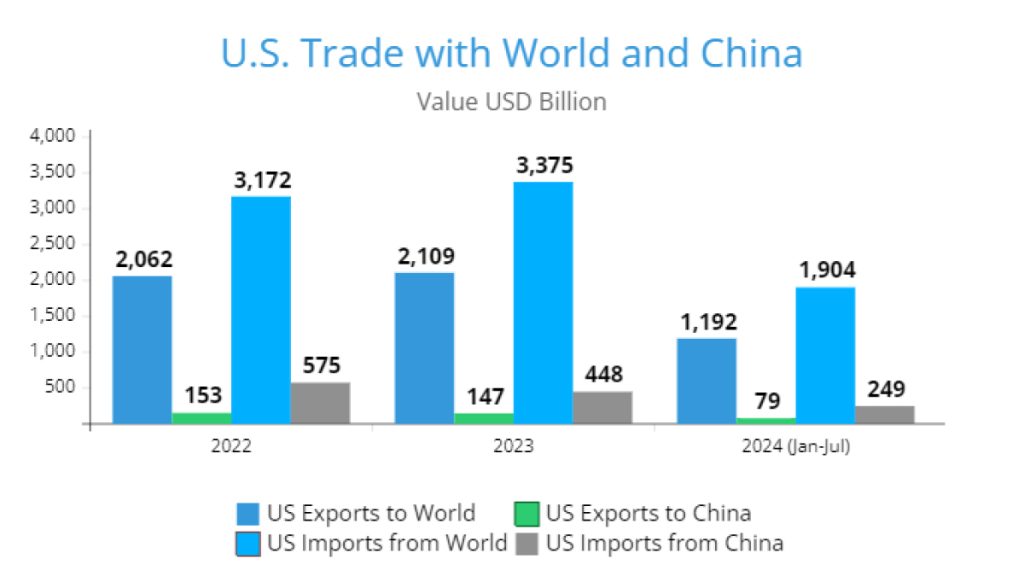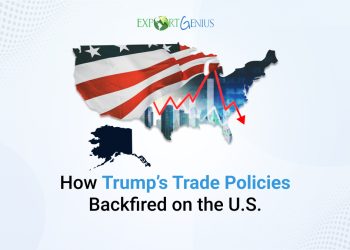The North American region was expected to record the strongest export growth in 2023 at 3.6%. However, this was below the export growth levels of the previous two years and is projected to decline to 2.7% in 2024. Trade tensions with China continue to impact US trade and supply chains, while November’s presidential election looms large on the horizon. The trade outlook is further clouded by unrest in the Middle East, with the supply chain affected by disruption to shipping traffic in the Red Sea area.
The US-China trade war remains disruptive for businesses and the global economy
Global trade continues to be shaped by tensions between the United States and China. The trade war between the countries has affected an estimated US$450bn in annual trade since it began in 2018-19. Trade barriers such as Section 301 tariffs imposed on China by President Trump in 2018, are still in operation. The Biden administration barred US exports of advanced semiconductors to China and is reportedly considering new tariffs on electric vehicles and certain minerals imported from China.
What is the total trade between the U.S. and China? What is the US exporting to China and importing from China? Let’s find out!
The United States of America exported goods to the world worth USD 2,109 billion in 2023, down from USD 2,062 reported a year earlier. From Jan to Jul 2024, the country shipped commodities to the world at a value of USD 1,192 billion. While, imports from the world valued at USD 3,172 billion in 2023, declined from USD 3,375 billion in 2022. America’s imports from the world totaled USD 1,904 billion from January to July 2024.
As the trade war between the US and China continues, their trade has been affected and went down. In 2022, US trade with China was USD 728 billion, which declined to USD 595 billion in 2023. Here’s data visualization for a better understanding of US trade with the world and China.

| Year | US Exports to World | US Exports to China | US Imports from World | US Imports from China |
| 2022 | 2,062 | 153 | 3,172 | 575 |
| 2023 | 2,109 | 147 | 3,375 | 448 |
| 2024 (Jan-Jul) | 1,192 | 79 | 1,904 | 249 |
*****Value USD Billion
Reasons for pessimism in global trade
Higher rates of interest and inflation
Collapse of cybersecurity
Economic downturn in key markets
Higher uncertainty of geopolitical developments
Global warming and extreme weather patterns causing supply chain disruptions
Rising governmental protectionism
Domestic opposition to trade and globalization
Tight labour markets
The resurgence of the new covid-19 strains or future global pandemics
Outdated and inadequate transport and logistics infrastructure
An ineffective multilateral trading system
The fragmentation of the world into trade blocs and regionalism
De-dollarization of trade
The global economy could be hit hard by tech decoupling
Once a key driver of globalization, technology has become a major source of trade friction, with the United States and China raising restrictions and reducing collaboration as the former seeks to prevent Chinese AI businesses from gaining access to US technology assets, evidenced by their export controls on semiconductors. According to a report, global output declined of 0.9%. Gross Domestic Product (GDP) in China and the United States would decrease by 1.9% and 0.9% respectively.
This reinforces the need for US businesses with supply chains across multiple geographies to boost supply chain resilience, such as establishing dual supply chains to mitigate risks from certain markets.
How geopolitical events are impacting supply-chain operations
Friendshoring
Dual Sourcing
Expanding into more neutral markets
Increasing the length of supply chains
Reducing the number of markets or suppliers
Moving supply chain closer geographically
Stress testing supply chains
The 2024 US election will shape the direction of trade
The future of the US-China trade war is totally dependent on the upcoming elections in November 2024. Should former President Donald Trump take office for a second time, he would likely intensity the trade war he began during his firth tenure. According to reports, Mr Trump is on record saying that he would include higher tariffs, targeted at China and new restrictions on Chinese ownership across a range of assets in the U.S., among other measures.
Yet, whoever wins, it seems likely that the current import restrictions on Chinese goods are likely to stay, and that could extend further into industries including renewable and electric vehicles. Such a scenario could affect the US supply chain and global trade disruptions.
For all major updates on US trade developments, visit Export Genius and access import-export data of global countries.






















